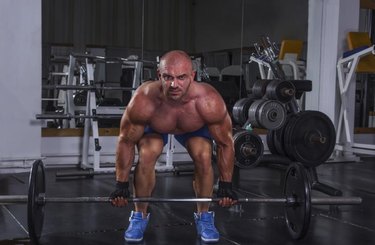
Developing a wide back is a much sought-after goal of anyone looking to build a muscular physique, as it makes your upper body look more impressive and commanding. The muscles that you want to target for a wide back are the latissimus dorsi, which you can work best with rows.
Read More: Back Row Exercises
Video of the Day
Video of the Day
Latissimus Dorsi
The latissimus dorsi, also known as the "lat," is the largest muscle in your upper body. It originates in your lower back, known as the lumbar spine, and works its way up to the middle of your back before stretching all the way out to your shoulders. This muscle, when it is well-developed, looks like a pair of wings coming out of the side of your back.
This big, powerful muscle acts to pull your arms down toward your body and in toward your sides, as well as rotate them internally (the same movement as giving a "thumbs-down). It also can help you exhale if you are breathing heavily.
Types of Back Exercise
If your goal is to get a wide back, you want to focus your training on working this massive muscle. If you develop it sufficiently, you'll start to notice it growing out to the sides. There are two main types of back exercises: vertical pulling and horizontal pulling.
Pull-Ups
Vertical pulling exercises, like the pull-up, involve pulling your arms down toward your body from an overhead position. In a pull-up, you initiate the movement with your lower trapezius and pectoralis major, which is your chest muscle. After these muscles kick in, the latissimus dorsi begins pulling your arms down, which pulls you up. According to a 2015 study in the Journal of Strength and Conditioning Research, the pull-up activated the latissimus dorsi to 83 percent of its maximum potential.
Read More: What Body-Weight Exercise Offsets Push-Ups?
Rows
Horizontal rows are slightly different because you are pulling your arms in from in front of you. It's the opposite motion of a bench press. The row is a good example of a horizontal pull. You can do a dumbbell row — where you lean over a bench, pick a dumbbell up and pull it in toward your chest — or you can do a barbell row, in which you grab a barbell, stick your butt back to lean over and pull the barbell into your sternum. You can also do an inverted row, where you lie on your back, grab a bar above you and pull your chest up to the bar.

Out of all of the row variations, the inverted row works your latissimus dorsi the most. According to a 2014 study in the European Journal of Sports and Exercise Science, the inverted row maximally activates the latissimus dorsi, making it the best exercise to develop a wide back.
- Journal of Strength and Conditioning Research: Surface electromyographic activation patterns and elbow joint motion during a pull-up, chin-up, or perfect-pullup™ rotational exercise.
- Strength and Conditioning Research: Latissimus Dorsi
- Dynamic Medicine: Variations in muscle activation levels during traditional latissimus dorsi weight training exercises: An experimental study.
- Journal of Strength and Conditioning Research: Comparison of Different Rowing Exercises: Trunk Muscle Activation and Lumbar Spine Motion, Load, and Stiffness